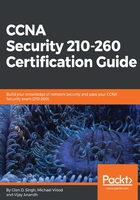
上QQ阅读APP看书,第一时间看更新
Endpoint security
Endpoint security deals with securing end user's devices and the authentication of inpidual users. In an organization, before remote users access the network resources, the organization defines some policies that check for authentic and non-pirated software before allowing the user to access the network. In Cisco, this is executed by using NAS.
Three different types of device or software can be identified as portfolios for endpoint security:
- Antivirus: Antivirus is a software that can protect the end user from harmful attachments, such as viruses, and malicious code, such as worms, which can cause huge business impacts to the organizations. An example is: Cisco Sophos antivirus technology (https://www.cisco.com/c/en/us/products/security/email-security/index.html).
- Personal firewall: A personal firewall goes one step further than antivirus and has the capability to block applications that may cause harm to a particular user. As an extension, it also uses HIPS and HIDS, similar to the network-based intrusion prevention system. An example is: Windows Firewall (https://www.microsoft.com/en-us/safety/pc-security/firewalls-whatis.aspx), Windows Defender (https://www.microsoft.com/en-us/safety/pc-security/windows-defender.aspx).
- Anti-spyware: Generally, when a user clicks on an advertisement on a webpage, there is high chance that spyware might get installed on the user's machine. This leads to the exploitation of the machine's resources. Anti-spyware helps to mitigate this situation and block the unwanted spyware. An example is: AVG Anti-Spyware (https://www.avg.com/en-ww/homepage#pc).